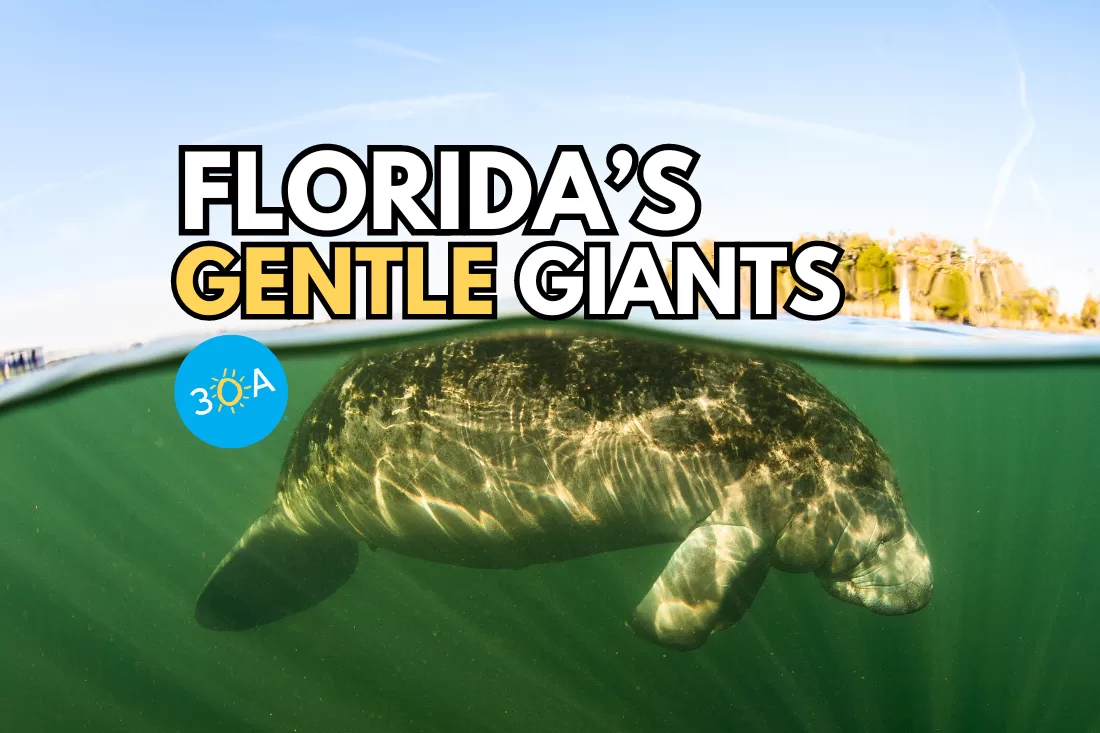Meet Florida’s Manatees: All You Need to Know About These Charming Creatures
Florida’s Adorable Sea Cows!
Florida’s Adorable Sea Cows!

No trip to Florida is truly complete without catching a glimpse of what some consider one of the cutest creatures in the sea – the manatee. Since manatees are slow movers, it’s not too hard to spot one if you know where to look.
We’ll give you the lowdown on these gentle animals and let you know where to find them in the Sunshine State.
Sometimes people are surprised by the size of manatees. There’s a reason these marine mammals are also known as sea cows – they have some heft to them. The average manatee can reach 13 feet and weigh up to 1,300 pounds, but females have the potential to be 15 feet in length and weigh as much as 3,900 pounds.
Once written off as dumb because of its orange-sized brain, manatees are no longer considered the ocean’s simpleton by researchers. Despite having one of the smallest brains proportionate to their body size out of all ocean mammals, manatees have shed their village idiot status.
Now, researchers believe they are as intelligent as dolphins when it comes to doing experimental tasks.

These gentle giants are herbivores, subsisting on weeds, algae, and seagrass. Since they can eat up to a tenth of their body weight in a 24-hour span, they spend a lot of time chowing down. Based on the size of the manatee, they can eat well over a hundred pounds a day in vegetation, or much more than that for bigger female manatees.
With little nutritional value in what they’re eating, it’s a good thing they eat it in bulk.
Christopher Columbus spotted three manatees on January 9, 1493, as he sailed close to the Dominican Republic. He mistakenly believed them to be mermaids and said they are “not half as beautiful as they are painted.”

Manatees aren’t capable of breathing underwater, but they can hold their breath a lot longer than most humans. Unless you’re a champion freediver, a manatee would beat you in a breath-holding competition. They can hold their breath for approximately 20 minutes underwater, although they prefer to come up for air every three to four minutes.
Manatees are one of the luckiest ocean animals in that they have no natural predators. Although crocodiles, sharks, killer whales, and alligators can kill manatees when they are underwater eating, it doesn’t happen often. That’s because they prefer different habitats.
While the predators often hang out in deeper waters, manatees like to stay in shallow water.
When you gaze at them, you cannot wait to adore their rounded, cuddly form. This endearing shape is a delightful result of their unique digestive system. Their large intestine is like a natural fermentation chamber, efficiently processing the challenging plant matter that makes up their diet. This nourishes them and contributes to their gentle, plump appearance, making them resemble the teddy bears of the sea.
It’s a wonderful blend of function and form, showcasing nature’s design at its most charming. These gentle giants, with their soft contours and amiable presence, remind us of the beauty in simplicity and the elegance of nature’s design.
Looking at a manatee, one can’t help but be drawn to their faces adorned with whiskers as sensitive and expressive as those of a wise old cat. These aren’t mere facial features but essential tools, similar to a natural sonar system.
With these whiskers, manatees can feel their way through the murky waters of their habitats, detecting the slightest changes in their environment. They navigate with a sense of touch that’s almost poetic, brushing against the water’s whispers and understanding its secrets. It’s a beautiful sensation and response, allowing them to move confidently and naturally in underwater explorations.
To get an up-close view, you can see manatees when you’re swimming or snorkeling, kayaking, or in a boat. Remember to mind your manners while viewing – give them the space they need and avoid touching them. If you’re intimidated by the thought of finding them on your own, you can always join a tour that will let you get up close and personal with some magnificent manatees.
Want to know specifically where to go to spot a manatee? Three Sisters Springs at Crystal River National Wildlife Refuge is a good choice, as is nearby Ellie Schiller Homosassa Springs Wildlife State Park. If you want to view manatees but aren’t a fan of boats or being in the water, Blue Spring State Park in Orange City is a great option, or you can head to Tampa Electric’s Manatee Viewing Center, a manatee sanctuary that has viewing platforms. To see them during the winter months, Manatee Springs State Park is a popular choice because of the warm spring located there.
For an unforgettable glass-bottom boat tour where you can spot manatees, check out Edward Ball Wakulla Springs State Park.

Manatees are gentle, slow-moving, and peaceful, so you might feel compelled to reach out and pet them if you find one nearby in the water. But that’s a bad idea. It can train them to lose their fear of humans – and that’s something which can wind up getting them killed someday.
You should also avoid giving manatees food to lure them in for a closer look.
What you’re trying to feed them may not be a part of their natural diet, so it could be bad for them. Also, they might start approaching other people for food – another habit that could lead to their death.
If you see a manatee, it’s okay to swim toward it slowly, as long as you keep a respectful distance. Don’t reach out to them, and try to avoid making too much noise or splashing around. Sudden or fast movements or too much activity can scare them.

